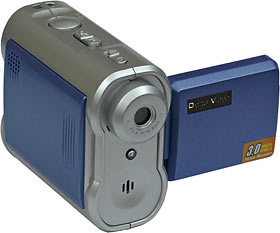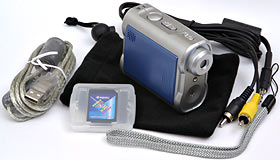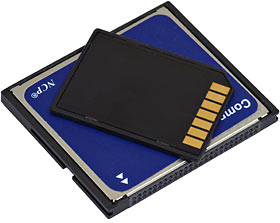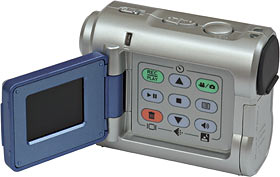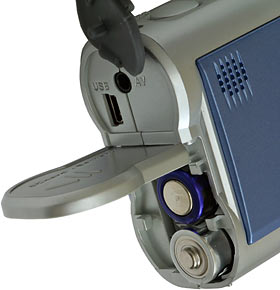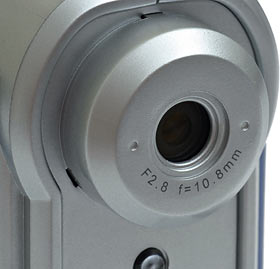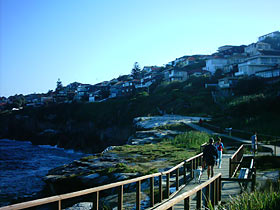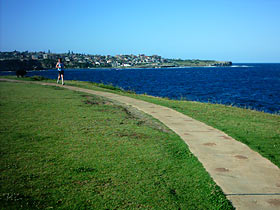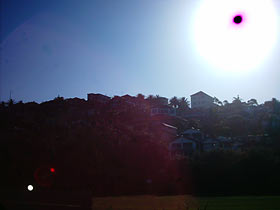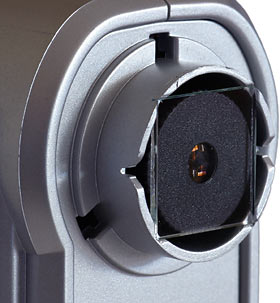
Mustek DV3000 digital camera
Review date: 7 November 2003.Last modified 03-Dec-2011.
I like baby digital cameras, and I particularly like the cheap and cheerful still-plus-video variety.
This is not news to regular readers, who've put up with me rabbiting on about the Aiptek Pocket DV2 and GrandVision CoolDV 350 on previous occasions.
These "super-toy-cams" have the basic problems of all baby digicams. Questionable lens quality, not-too-great user interfaces, slow shot-to-shot times, no flash - but they do have expandable memory and a little LCD screen. They fit in your pocket, they run from two AA batteries and they can shoot video clips as well as stills. And they cost about the same as a rock bottom entry level "proper" digicam - something like a Kodak Easyshare CX6200 or Olympus Camedia C-150 (also known as the D-390).
Super-toy-cams aren't dirt cheap keyring trinkets like the tiniest toy-cams, and if all you want to do is shoot stills then the basic Kodak or Olympus is a better choice. But you can't beat the Aiptek/GrandVision/whatever cameras' feature list at this price.
People who keep up with the toy-cam scene will recognise this as the Mustek DV3000. And, in all important respects, it is. It just doesn't have the Mustek brand anywhere on it or its packaging. It's not a white-box cut-down "OEM" version, though; it's the same thing, made in the same factory, and sold in nice retail packaging with a full bundle of extras. There are just some different-coloured panels, and no maker or model name anywhere in sight.
Here in Australia, Aus PC Market were (but, as of late 2004, are no longer) selling this camera under the Mustek DV3000 name, because that name's as good as any, and this really is the same product. If you don't call it the DV3000, you've just got to make one up, so I'll call it the DV3000 too.
The DV3000 is obviously related to the Aiptek/GrandVision/whatever baby-cams. This makes life easier for Dan the Lazy Reviewer; read those two reviews first and then come back here for the diff.
What you get
The DV3000 kit gives you the camera, a little drawstring bag for carrying it, a USB cable, an RCA A/V cable for TV output, a wrist strap, and a 32Mb memory card. The DV3000 has no internal memory, and uses SD/MMC cards for storage.
There's also decent paper documentation, a couple of alkaline AA cells (which'll last quite well; you don't have to rush out and buy rechargeables) and a software CD, which I left out of the above picture.
As with the other super-baby-cams, the USB connection lets you use this camera as a USB Mass Storage Device on Win98/Me/2000/XP PCs and Macintoshes running USB-aware versions of Mac OS, plus Linux 2.4.x. So you shouldn't need a separate card reader, especially if you stick with the one bundled memory card.
Windows users can also use the DV3000 as a Webcam, again via USB. It doesn't come with a little folding tripod, but it does have a standard-thread tripod socket on the bottom, so you can attach it to the tripod of your choice. The tripod thread's only plastic, but never mind the quality, feel the price.
I'm not crazy about the choice of SD/MMC as the card format for this camera (the above picture shows the included MMC card on top of a CompactFlash card), but it's not really a big deal. CompactFlash is the choice of professional photographers, partly because of its greater physical robustness and partly because of the ultra-capacity cards now available - 1Gb cards are common these days, and 2 and even 3Gb models are available. Since even 32Mb is likely to be quite adequate storage for a toy-cam, though, the mere 512Mb ceiling of SD/MMC (512Mb SD/MMC cards they cost about 1.5 times as much as 512Mb CompactFlash cards) doesn't matter.
As usual for memory cards (among other storage devices), the one that comes with the DV3000 isn't quite as big as the sticker says. Its formatted capacity is only 30.2Mb.
Specs
A sticker on this camera claims "3.0 Mega Pixels Picture Resolution"; and on Mustek's DV3000 product page claims three point one megapixels.
And, indeed, its top resolution is an impressive (for a toy-cam) 2048 by 1536 pixels; 3.15 megapixels.
Mustek freely admit, however, that the camera only actually has a 2.1 megapixel sensor. This means its 1600 by 1200 medium resolution (low res mode is 640 by 480) is the real picture size.
And yes, that's only 1.92 megapixels. The difference is because of that old effective pixels magic.
The top resolution is supposed to be achieved by "hardware interpolation". Dressing up interpolation (scaling up the image) with the word "hardware" could mean that you actually will end up with higher real image resolution than you might expect, thanks to the hardware having access to the raw colour filter array data. But this is a toy-cam, so you shouldn't expect too much.
The DV3000's video clip resolution, like that of the earlier super-toy-cams I've reviewed, is 320 by 200. Also like them, it spits out MJPEG-compressed AVI files which most Windows users should be able to play with no trouble (those trapped in codec error hell are cordially requested to direct their kind enquiries to one William H. Gates the Third). Also in sync with the older cameras, the DV3000's clips have 32kHz, 4 bit mono audio tracks; as usual, the sound quality is surprisingly good, thanks to a sensitive microphone behind a little grille below the lens.
Unlike the earlier cameras, the DV3000 has two video quality modes. In high quality mode it does about 13 frames per second; that drops to 7fps in low quality mode, and the video compression's harsher, too. The result is files around half the size, though, and the audio's just as good; it's surprising how much difference a nice clear soundtrack can make to a barely watchable video.
The DV3000 is a mere 86 by 40 by 68mm (3.4 by 1.6 by 2.7 inches) in size, and weighs 110 grams (3.9 ounces) without batteries.
Controls and features
The DV3000 doesn't have even a token optical viewfinder (so framing shots in bright sunlight isn't much fun - that mighty one and three-eighth inch LCD screen washes out easily), and it doesn't have an off switch that triggers when you close its screen.
The camera does, however, have a pleasingly complete control set.
The top of the camera has a shutter button, the particularly cheesy feeling momentary-slide power switch, and a zoom control. You don't get optical zoom, of course; there's 2X digital zoom, which might be useful for framing shots but will hurt resolution, unless you're shooting in 640 by 480 mode.
You can't use the zoom while you're recording video, but you can set it beforehand and then shoot at that zoom level; the DV3000 doesn't snap back to un-zoomed mode when you start video recording.
When you open the screen...
...you get a lot more controls. Which is great. No separate record buttons for stills and video; you just switch between still and video mode with one button. No menu-diving to change quality mode, either; there's a button for that, too.
You also get a separate button for low-light mode, which boosts gain for video clip recording a bit, but really shines for indoor still photography. At last, a proper stutter-vision long-shutter-speed mode in a super-toy-cam!
There's also a button for record/play mode switching, and for deleting files, and for activating menu mode, and for activating the ten second self-timer... you get the idea.
You can also press one button to turn off the LCD screen, so you don't waste battery power in long AVI recording sessions, or when you're just walking around with the camera and want it to be ready.
Some buttons do double duty for different modes, but none of the important features clash and have to be broken out into a menu. There is a config menu, but it has only five items, and they all fit on the little screen at once. There's an auto-off option in there for the forgetful, and a PAL/NTSC switch for the TV output, and a 50/60Hz electricity supply flicker-reduction setting for video recording, and a memory card format option, and one to turn off the camera's beeps. And that's it.
The camera's USB and A/V connectors lurk under a little rubber flap on the back, and the batteries and card slot are under a none-too-solid slide-to-disengage plastic door. The flimsiness of the door means it's probably a better idea to transfer images from the DV3000 by using its USB lead than by popping out the card and putting it in a separate reader.
Not always, though. My review camera came with an oddly corrupted memory card; it caused the camera to display its "NO CARD" warning and then promptly turn itself off. Formatting the card in a USB reader fixed it; if I hadn't had the reader, I would have been stuck.
Since the low price for USB1.1 MMC/SD-only card readers is now below $AU30, with multi-slot reads-anything units not a great deal more expensive, it's not a bad idea to get one anyway.
The DV3000's lens is, as usual, a teeny little spycam-ish unit hiding inside a chunky plastic surround. It's alleged to be 50mm-equivalent, which means it should have the same roughly 45 degree horizontal field of view as a 50mm lens on a 35mm film camera. Its real focal length is much shorter, but it's aimed at a tiny little CMOS sensor; short focal length lenses pointed at small sensors behave like longer lenses pointed at bigger sensors, as far as field of view goes.
A lens with about a 45 degree field of view is known as a "normal" lens, because it approximates the field of view of human vision. People have peripheral vision out rather further than that, of course, but what normally sighted people perceive as their view of the world is a roughly 45 degree slice out of the middle.
50mm is not very wide angle, so it's not the greatest choice for indoor photography if you want to get the whole room into the frame. It's a good general purpose focal length, though.
When I actually tested the DV3000, I found that its real field of view made it more like a 58mm-equivalent lens - significantly more telephoto than its specifications suggest. The difference isn't huge, but it's enough to make this camera particularly unsuitable for wide-angle use. Conversely, though, it makes it easier for you to fill the frame with a subject without climbing up their nose.
The lens has some kind of funky red coating on it which may or may not do something (the last time I saw a little lens this colour it was on the worst webcam I've ever reviewed...), but apart from that it's par for the toy-cam course. No optical zoom, of course, but no focus adjustment, either.
The other super-toy-cams have focusable lenses, which are great as long as you remember to use them. Video clips are low-res enough that it hardly matters, but "focus free" lenses like the DV3000's are factory-set with a reasonably close focal point so that they won't be useless for indoor photography, and that close focus means they can't help but be rather fuzzy on distant subjects.
Still, the lenses on the other super-toy-cams just aren't very good, focus or no focus. A fixed focus lens with better optical quality could beat them easily.
The damage
Here in Australia, Aus PC Market were selling the DV3000 for $AU247.50 (they've moved on now) including delivery anywhere in the country, which is pretty darn good for a package including a 32Mb memory card. It'd be nice if there was a little tripod included as well, but you can't have everything.
In the USA, Mustek sell direct for $US169.99, but that's not anything like the best price out there. Actually, at current exchange rates, that's about the same price as Aus PC Market are charging - Aus PC's price includes delivery.
If you shop around, though, it's easy to find a DV3000 for $US130 plus shipping.
Testing
When I started playing around with the DV3000, I noticed a few things.
One, it can take better pictures than most toy-cams, and it's definitely better than the last two Aiptek/GrandVision/whatever super-toys I've played with, for many shots.
This is purely because the DV3000 has a half-decent lens. Toy-cams generally have lenses no better than those on cheap webcams; this means many shots have nasty circular distortion effects around the edges.
The DV3000's lens doesn't do that. It's definitely not perfect, though; more on that in a moment.
The other thing I noticed is that the DV3000 ain't no three megapixel camera. I took full and medium resolution shots of the same scene, Photoshop-scaled the full-res one down to 1600 by 1200, and compared them; the medium-res original was slightly sharper, but there was no real difference in image quality. Scaling up the medium-res picture and comparing it with the full-res one showed a little less colour noise in the full-res image, but it still wasn't quite as sharp. Again, the quality difference was trivial.
Far worse interpolation crimes have been committed than this, but there still seems to be no point using the DV3000's 2048 by 1536 mode. The only difference between full resolution and 1600 by 1200 is in time and memory card space.
On the subject of which - the shot-to-shot time (time between taking one still picture and being able to take another) for the top resolution mode was a lazy 12 seconds. 1600 by 1200 was a still-unexciting nine seconds; 640 by 480 took six seconds.
This, plus significant shutter and exposure setting lag, means that the DV3000 is not a camera for fast action photography. But no toy-cam is, and cheap consumer cameras are often pretty lousy in the response-speed department too.
File sizes varied quite widely depending on what was in the shot, which is a good sign; it means the DV3000's got some proper JPEG muscle-work happening inside its little body while it labours to get ready for another shot.
The worst case scenario for full-resolution file sizes seems to be almost a megabyte, but 600 to 800 kilobytes seems much more likely. 1600 by 1200, the resolution you should be using, worked out at about 55% of this file size; at this resolution, you could easily fit 80 images on the bundled card (assuming you don't shoot any video), and you can count on getting at least 50. 640 by 480 mode is about 55% the file size of 1600 by 1200.
Many toy-cams forget their settings whenever you turn them off, and default to the same mode every time you fire them up again. The DV3000 only does this slightly; when you turn it on, it always defaults to movie mode. You only have to press one button to switch to still mode, though, and the camera remembers what quality level you last selected for each mode. It even holds the settings if it loses power; pop the battery door for as long as you like and the quality settings still stick. Nice.
By toy-cam standards, this picture is a revelation. Good detail all the way to the corners, strong colour (rather stronger than the real scene, actually, but happy snappers like their colours pumped up like this, so it's no bad thing that the DV3000 does it), good exposure, even a decent-looking sky. There's a bit of a colour cast, but it was real; the sun was getting low over to the right, and the hillside was falling into blue shadow.
Click the above picture and you'll get an 800 by 600 version; bandwidth-suckers who want a 1600 by 1200 one can click here. I've recompressed it to save space, but the quality loss is almost imperceptible.
Another surprisingly good looking still. The grass isn't really that green, but it looks nicer in the picture than in real life, and there's detail in it without the colour-noise-storm that spoils many toy-cam pictures. And the headland in the distance isn't awfully blurred, either. And the sky's good, again. And the roughly 1/1000th shutter speed's frozen the jogger off the ground, in case you care about that.
1600 by 1200 version here.
Little CMOS sensors don't like looking at the sun. Point them at it for long and you can damage them permanently, as people who've done time-lapse shots of the sky with a webcam often find out.
As well as the funky black hole sun effect, though, check out the flare artefacts towards the lower left corner. This lens is a bit more prone to flare - internal reflections that make it to the image sensor - than that of most baby-cams.
That said, though, the DV3000's dealing bravely with this cruel treatment. There's still some detail in the houses, and there's colour in the sky. 1600 by 1200 version here.
OK, so that's the good news.
When I did my usual indoor test shots with the DV3000, at ranges of a metre or less, I got hopelessly blurry results. The camera is meant to have a 70cm to infinity focal range (which is fixed-focus-lens code for "a bit blurry at 70cm, and a bit blurry for distant subjects"), but the realistic minimum focus distance for my review camera is more like two metres.
The reason for this is simple enough - the lens just isn't screwed in quite as it's meant to be.
There's no focus ring on the DV3000's lens, but experienced toy-cam fiddlers won't be daunted by that. Cameras that use little commodity CMOS imagers also usually have normal screw-on lenses. Remove the decorative plastic and you can often adjust them. They may be rather stiff, and you have to tweak and shoot and tweak and shoot to get the setting right. But if you want to get true infinity focus out of one of these cameras, or wind it in for ultra-macro work, you often can do it.
It was the work of a moment to remove the DV3000's clip-on lens surround, but then I saw this.
That's a square of what looks like perfectly ordinary glass over the lens. The glass doesn't seem to be specially coated, or anything; it might be an IR filter, but I suspect it's just a bit of glass, held in place by friction. It's no doubt responsible for the DV3000's unusually enthusiastic lens flare - but it keeps crud off the lens, as well.
Unfortunately, once you pop the glass off, the lens proper is still surrounded by the plastic the glass mounted to. Because this is a classic super-stiff mini camera module lens, you can't just dig a couple of paper-clip-ends into the plastic housing around the lens and turn it; it really needs to be gripped, and you can't do that properly without cutting off the surround plastic. Nosing in there with some implement or other doesn't give you fine enough control.
I decided not to mutilate my review camera to explore this issue further.
I don't know how consistent the focal distance of other DV3000s is likely to be. Mine was a random retail sample, and people don't seem to be complaining to Aus PC Market about fuzzy indoor shots, so maybe mine was a fluke.
Focus aside, the DV3000 did a good job on indoor stills. It managed decent exposure, perfectly good white balance, and good low light results, too. This is unusual.
"Low light", in the opinion of many toy-cams, covers just about all indoor night-time shots, and they suck at it. You may have no trouble reading small print in the room, but a lot of toy-cams will have a hard time taking a picture. They commonly refuse to even try, and just bleep at you to tell you to turn on some more lights.
Normal indoor night-time illumination is likely to be somewhere in the range of 20 to 80 lux. In its normal photo mode, the DV3000 can manage decent exposures with illumination a bit below 100 lux. In stutter-vision night mode, it's happy with about 30 lux.
Candlelight this ain't, but by toy-cam standards it's superb, and the DV3000 won't ever refuse to take a shot just because it reckons you're at the bottom of a coal mine during a solar eclipse. You want a black frame? You'll get a black frame. It'll compress really well.
The other side of this coin is that you can't hand-hold the camera for low light shots. The DV3000's slowest shutter speed is 1/15th second, and that's what it's likely to use for almost every night-time photo; it's the price you pay for nice bright low light pictures without a flash. In stutter-vision mode the camera's overlaying consecutive frames on top of each other, so it probably has a de facto exposure that's twice as long again.
There's a standard photographic rule of thumb that says that no living human can get a sharp picture by hand-holding a camera and using an exposure longer than one-on-the-35mm-equivalent-focal-length seconds (disregarding modern image stabilisation innovations). So the DV3000's 58mm-ish lens means that 1/15th is about four times as long as you can hand-hold without blurring your picture.
This doesn't mean you have to get a tripod, though; it just means you have to rest the camera on something. Push it up against a doorframe, sit it on a table, whatever. A little bean-bag is helpful in situations like this.
Overall
Like all toy-cams, the DV3000 isn't the camera for everybody. If you need better image quality than a toy-cam can provide (this one's good, but it's still not up there with "real" digicams), if you need faster response, if you need zoom, if you need autofocus, if you need more resolution - then don't buy a DV3000. Better you should save your money for a camera that'll do what you need, or pick up a second hand digicam that suits your current budget, than buy something cheap new that won't be useful to you.
If you want a little tiny camera that doesn't feel cheap and cheesy, doesn't have long shot-to-shot times, takes decently sharp pictures at its maximum resolution, blah blah, there are plenty of options out there. One or another Canon Digital IXUS/Elph, for instance, or a Casio EX-Z3 (don't bother with the newer EX-Z4; it's got more sensor resolution, but the lens can't really support it).
The lowball ex-delivery eBay price for an EX-Z3 these days, though, is still around $AU525 ($US370 or so); you're looking at the same kind of money for a new IXUS/Elph.
Ignoring shipping fees, you can therefore buy almost three DV3000's for the price of one of the little metal-cased sexy-cams. They're not in the same class at all.
As I've said before, super-toy-cams are an absolutely great product for a lot of people. So small! So light! So cheap! AVI video clips, right out of the camera! Strap it to your model plane - it's got no moving parts to shake loose! Carry the little fuzzy bag with you all the time and be ready to make art wherever you are! Plug it into the TV at parties! Or the VCR - leave your computerless hosts with a VHS tape of your photos! Et cetera!
As I mentioned at the top of this review, you can find more serious digicams for the same price as the DV3000. If all you want is still photography, then a base-model Kodak or Olympus is a better choice.
Super-toy-cams aren't as silly as they look, though. And the DV3000, despite its quirks, is the best I've seen so far.
Recommended.
Buy one!
Aus PC Market don't sell this
camera any more (click
here to see their current camera-related products), but you can still
try a price search at
DealTime!
